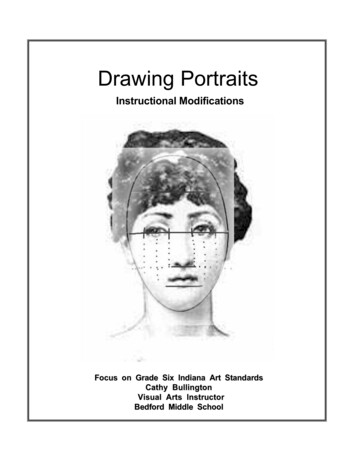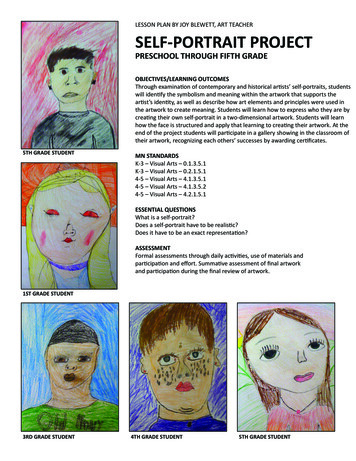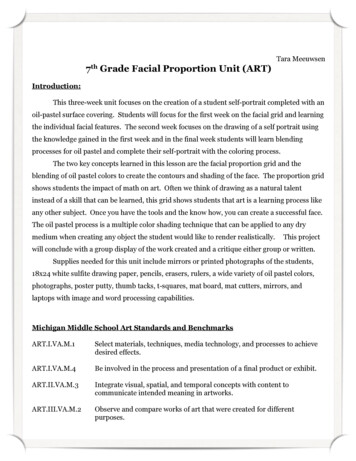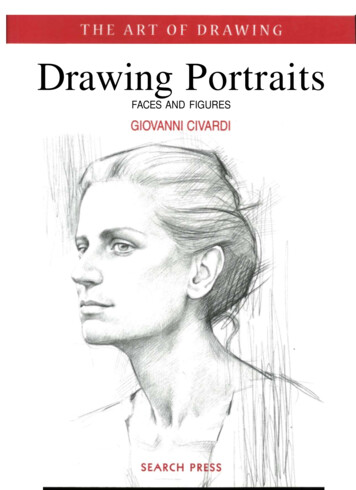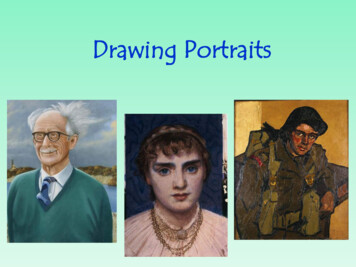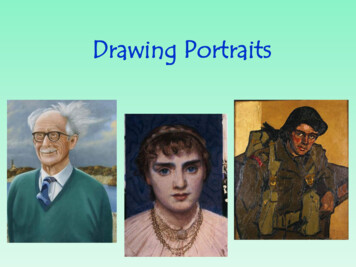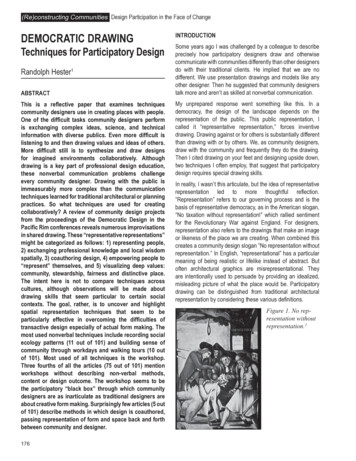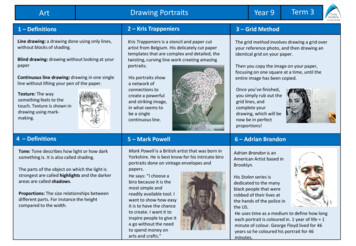
Transcription
ArtDrawing PortraitsYear 9Term 31 – Definitions2 – Kris Trappeniers3 – Grid MethodLine drawing: a drawing done using only lines,without blocks of shading.Kris Trappeniers is a stencil and paper cutartist from Belgium. His delicately cut papertemplates that are complex and detailed, thetwisting, curving line work creating amazingportraits.The grid method involves drawing a grid overyour reference photo, and then drawing anidentical grid on your paper.Blind drawing: drawing without looking at yourpaperContinuous line drawing: drawing in one singleline without lifting your pen of the paper.Texture: The waysomething feels to thetouch. Texture is shown indrawing using markmaking.4 – DefinitionsTone: Tone describes how light or how darksomething is. It is also called shading.The parts of the object on which the light isstrongest are called highlights and the darkerareas are called shadows.Proportions: The size relationships betweendifferent parts. For instance the heightcompared to the width.His portraits showa network ofconnections tocreate a powerfuland striking image,in what seems tobe a singlecontinuous line.Then you copy the image on your paper,focusing on one square at a time, until theentire image has been copied.Once you’ve finished,you simply rub out thegrid lines, andcomplete yourdrawing, which will benow be in perfectproportions!5 – Mark Powell6 – Adrian BrandonMark Powell is a British artist that was born inYorkshire. He is best know for his intricate biroportraits done on vintage envelopes andpapers.He says: “I choose abiro because it is themost simple andreadily available tool. Iwant to show how easyit is to have the chanceto create. I want it toinspire people to give ita go without the needto spend money onarts and crafts.”Adrian Brandon is anAmerican Artist based inBrooklyn.His Stolen series isdedicated to the manyblack people that wererobbed of their lives atthe hands of the police inthe US.He uses time as a medium to define how longeach portrait is coloured in. 1 year of life 1minute of colour. George Floyd lived for 46years so he coloured his portrait for 46minutes.
Computing1: Features of a word processorSoftware – Programs used on a computerWord processor – A word processor allowsyou to type letters/symbols/wordselectronically and save, print, and edit thedocument.Browser – Software that allows you to accessthe internetFormatting – Change the appearance of thedocumentWhy do we format documents To make the text easy to read To make it easy for the audience toextract the information that they need To highlight the important information4: Research and planBlog – A blog is a discussion or informationalwebsite published on the World Wide WebResearch – To try and find information.Citation – A word or piece of writing takenfrom a written workPlagiarism – The process or practice of usinganother person’s ideas or work andpretending that it is your ownParaphrase - To repeat something written orspoken using different words, often in ahumorous form or in a simpler and shorterform that makes the original meaningclearerUsing Media2: Licensing images Copyright – A law to protect peoplecopying their work Adaptations – Are changes andmodifications Copyright license – Is an agreement inCopyright law. Commercial use - Making money fromsomething Cropped – removing unwanted areas ina picture Text wrapped - a feature in MicrosoftWord that allows you to surround apicture or diagram with text.Year 9Term 33: Credibility of sourcesCreditability – Being trusted and believedin.Trustworthy – being relied on as honest ortruthful.Hyperlink – a link to another locationSource – The place or thing wheresomething comes from.Implication – the effect that an action ordecision will have on something.Contribute – something that you do to helpproduce or achieve something.Target Audience – a group of people thatsomething is aimed at.Charity – Giving help to those in need.5: Promoting your cause6: Example blogs Promoting – the publicising of cause. Appropriate images – images suitable for theblog. Attribute to author – stating where you gotthe information from. Referenced – links to where the informationwas collected from. Microsoft Word – a word processing software,mainly used to type reports, create tables. Publisher – is a desktop publishing softwareused for leaflets, Poster and Menus etc.IGN – Video games bloggingHuffington Post – A news blogFood 52 – Food bloggingRose and Vintage – Fashion blog
DramaGreek Theatre1: Greek Theatre Origins A festival honoring the god Dionysus was held in Athens, out ofwhich three dramatic genres emerged: tragedy, comedy andthe satyr play. The plot of a tragedy was almost always inspired by episodesfrom Greek mythology. A myth is a well-known story which was made up inthe past to explain natural events or to justify religious beliefs.Year 9Term 32: Greek Chorus A typical Greek chorus consisted of a group of 12 to 50 playerswho spoke or sang their lines in unison, wore masks, andfunctioned as one actor rather than a large group of individualperformers. The purpose of the Greek chorus was to provide background andsummary information to the audience to help them understandwhat was going on in the performance. They commented on themes, expressed what the main characterscouldn’t say (like secrets, thoughts, and fears) and provided othercharacters with information and insights. Because Greek theatres were so large, the members of the chorushad to work hard to look and sound like one person.3: Mask TheatreMask: a covering for all or part of the faceIf you’re using masks in your performance remember that your facialexpressions can’t be seen so: your body language has to be extremely clear your movement and gestures need to be exaggerated to showemotions you must bring your whole body into the performance4: NVC SkillsNon Verbal Communication (NVC) relates to the way movements,posture and gestures can show how someone feels withoutspeaking.facial expression: the appearance, mood or feeling conveyed by aperson’s faceposture: the position a character holds themselves in when sittingor standinggesture: a movement made by part of the body (e.g. arms, head)to convey a character’s emotionsgait: a person’s manner of walking
DramaGreek Theatre5: Vocal SkillsYear 9Term 36: Performance Skills Pitch: the degree of highness or lowness of thevoiceTo ensure that you give an effective performance in thestyle of Greek theatre, the skills and points below shouldbe incorporated: Pace: the speed at which someone speaks· Greek Theatre Techniques (Box 2 and 3) Tone: a quality in the voice that expresses thespeaker’s feelings or thoughts· NVC—Non Verbal Communication (Box 4)Volume: the degree of loudness or the intensity of asound· remain in character ·Vocal Skills (Box 5)· don’t have your back to the audienceOracy Focusoracy: the ability to express oneself fluently andgrammatically in speechvolume: ensure that your voice reaches everyone in theaudienceclarity: ensure that you speaking clearlypace: ensure that your pace of speech is appropriate toyour character
English‘Short Stories’: Remote LearningYear 9Term 31: Vocabulary2: Terminologyconveys (verb): to express a thought,feeling or idea.Atmosphere: the tone or mood that comesabout during a certain scene or event.deduce (verb): to reach an answer ordecision by thinking carefully about theknown facts.Chronology: the order in which somethinghappens in a story.denouement (noun): the final outcome ofa storyhighlights (verb): to attract attention ormake something stand outForeshadowing: is a literary device in which awriter gives an advance hint of what is to comelater in the story.Narrative Perspective: the person who is tellingthe story, or the narrator, as well as the characterfrom whose point of view the story is told.omniscient (noun): knowing everything— Setting: the place or type of surroundings wheresomething is positioned or taking place.an omniscient narrator knows everythingSuspense: the intense feeling a reader goesthat happens in a story.through while waiting for the outcome of certainrealisation (noun): the moment of starting events leaving the reader wanting moreto understand a situationinformation.Syntax: the way in which words are put togetherto form a sentence.
English‘Short Stories’: Remote Learning3: Grammar Pop: Sentence TypesYear 9Term 34: Narrative Arc main clause: a sentence that can stand alone e.g. The dog went for a walk. subordinate clause: a clause at the start of asentence that depends on the main clause e.g. When the dog cried, the owner took him for awalk. simple sentence: a sentence with only a mainclause e.g. She knocked the mug off the shelf.Narrative: story compound sentence: at least two simplesentences joined together e.g. She moved too quickly and knocked the mugoff the shelf. complex sentence: a sentence with a subordinateclause and a main clause e.g. She moved too quickly and knocked the mugoff the shelf, but it didn’t break.Narrative Arc: the typical chronological order of events that takeplace in a story. As seen in the image above.Exposition: (opening) the background information within anarrative that sets the story up.Rising Action: the part of the story after the characters andsetting are introduced and where the events of the story begin tocreate suspense.Climax: the most intense, exciting, or important point of thenarrative.Denouement: (ending where all is explained) the final part of aplay, film, or narrative in which the plot is drawn together andmatters are explained.
FrenchLifestyle1: Lifestyle Vocabularyl’alcoolle bonbonle déjeunerl’eaule goûterles légumesles poumonsle régimele repasle sommeille tabagismel’alimentationla droguela formela nourriturela peaula santéYear 92: Infinitive Structuresalcohol accrosweets kvegetablesdélicieux/eusedéprimé /elungsgras/sedietivremealmaladesleepsmoking malsain/enutrition égétarien/neskinen bonne santéhealth3: Pour Infinitive Verbaddicted Impersonal structures often start with ‘il’ as they arealcoholic general statements not related to a particularallergicperson. For example:organicyou must/it is necessary todisgusting il faut ilestinterditde it is forbidden todeliciousilestnécessairede it is necessary todepressedilestimpossiblede it is impossible tofattyil est facile de it is easy todrunkillThese are followed by an infinitive verb. For example:unhealthyfaireto doboireto drinkhealthyfumerto smokese détendre to relaxsaltygarderto keepdormirto sleeptastyprendreto takese droguerto take drugssweetto avoidresterto stayvegetarian éviterfit/healthy e.g. Il faut éviter le stress You must avoid stress4: Present Tense5: Perfect Tense (avoir and être)To conjugate verbs in the present tense we removethe –infinitive ending and add the correct ending tomatch the person doing that action:We use the perfect tense to describe what has happened inthe past. It is made up of three parts:1.A pronoun or noun (e.g. je, nous, or a name)2.The auxiliary verb (usually avoir, but sometimesêtre)3.A past participle (e.g. regardé, fait)Past participlesVerb ER verbendingeeseonsezentIR verbendingisisitissonsisseziissentRE verbendingssonsezentmanger je mange I eat/I am eatingfinir nous finissons we finish/we are finishingattendre vous attendez you wait/you are waitingPast participle endingéTerm 3iuSome past participles are irregular, for example:dire dit (said)faire fait (did)écrire écrit (wrote)voir vu (saw)For verbs which take être the past participle must agreewith the subject. For example:elle est allée – she wentnous sommes allés - we wentTo express a purpose in French we use the prepositionpour infinitive verb. Pour can mean ‘for’ or ‘in orderto’.In English we often ignore the ‘in order’ part. But if thesentence in English would make sense using ‘in orderto’ you must use pour in French. For example:Je fais de l’exercice pour garder la forme.I do exercise (in order) to stay in shape.Il faut boire de l’eau pour rester hydraté.You must drink water (in order) to stay hydrated.Je joue au basket pour me détendre.I play basketball (in order) to relax.This stays the same in all tenses:Je vais manger des fruits pour rester en bonne santé.J’ai évité les bonbons pour garder la forme.6: Near Future TenseTo form the near future tense we use the verb aller plus aninfinitive verb. For example:je vais manger les légumes I am going to eat vegetablesnous allons faire de l’exercice we are going to chatje ne vais pas fumer I’m not going to smokeWe can also use a range of other structures to express thenear future tense. These are also followed by an infinitiveverb. For example:j’espère(I hope to)j’ai l’intention de(I intend to)j’ai envie de(I want to). j’espère garder la forme I hope to stay in shapee.g.We use ce sera (it will be) to give opinions in the near future.
GeographyRivers and Coasts in the UKYear 9Term 31: Water Cycle2: Long profile of the River3: How are rivers important to us?Water on Earth is constantly moving. It is recycledover and over again. This recycling process is calledthe water cycle.1. Water evaporates into the airThe sun heats up water on land, in rivers, lakes andseas and turns it into water vapour. The watervapour rises into the air.2. Water vapour condenses into cloudsWater vapour in the air cools down and changesback into tiny drops of liquid water, forming clouds.3. Water falls as precipitationThe clouds get heavy and water falls back to theground in the form of rain or snow.4. Water returns to the seaRain water runs over the land and collects in lakesor rivers, which take it back to the sea. Long profile: shows the gradient of a river as itjourneys from source to mouth. It spans thesource of a river and the mouth. It is separated into three different river courses. Upper course: is found in an area of high relief.Water trickles from saturated land and mergesto form a channel. In the upper course, theremay be rapids and waterfalls as the river flowsthrough steep V-shaped valleys. Middle course: is further downstream and therelief is usually hilly. The gradient of the longprofile becomes more concave as thevertical erosion reduces. Lower course: is closest to the mouth of theriver where the land is low-lying. The gradient isalmost flat due to the lack of vertical erosion. Importance: the value something has Economic: relating to money or jobs Development: grow and become more mature,advanced, or elaborate. In the UK humans use rivers for irrigation inagriculture, for drinking water, like swimmingand boating. for transportation, to produceelectricity through hydroelectric dams, and forleisure activities Rivers can also cause damage to us as well. Whena river floods it can damage buildings, roads,parks, wildlife, and cost a lot of money to repair. However, human use rivers in a negative way aswell. They use them for dumping chemical ordomestic waste, littering, and leisure activities,which may pollute the water and disrupt wildlife.4: Erosion and Deposition5: Coastal Landforms5: How can we stop erosion? Erosion – this is where material is taken awayby the sea or a river. Abrasion: this is when pebbles grind along arock platform, much like sandpaper. Attrition – this is where rocks collide andbecome smaller and smoother. Hydraulic Action – This is the force of river orsea eroding a cliff or river bank. Solution – this is where rock is dissolved by thesea or river and carried away. Deposition – this is where material is droppedby the river or the sea. Where the water flows the fastest or wherethe wave has the most power. This is wherethe most erosion of material occurs. Landform: this is a feature on the Earth'ssurface. Landforms on a coast are created dueto the different types of rock. Soft rock erodesquicker than hard rock. Think back to theGeology lessons.There are two methods to stop erosion on thecoast and on a river.1) Man Made structures. Also known as hardengineering. These can be sea or river wallswhich absorb the energy of a wave to reduceerosion. These are very effective atprotecting cities and towns. However, the arevery expensive.2) Natural methods. Also known as softengineering. These methods use the naturalworld to protect the coastline. This is wheresand is added to a beach or trees are planted.These are low cost but they are not aseffective as hard engineering.
HistoryThe HolocaustYear 9Term 31 – Rise of Persecution2 – Death Squads Hitler became Chancellor of Germany in 1933. The Nuremburg laws in 1935 did thefollowing: Removed Jews as German citizens Banned marriage between Jews and Aryan Stopped Jews from voting Jews fled Germany from 1933 onwards. Jewish synagogues were burned down duringKristallnacht in 1938. After Operation Barbarossa (the invasion ofthe Russia in 1941) 4 million Russian-Jewscame under Nazi control. Jews were rounded up by SS units called the‘Einsatzgruppen’ also known as ‘DeathSquads’. They would shoot mass groups of Jews, oftenafter making them dig their own graves. 1.2 million Jews killed by Death Squads. The persecution of the Jews progressed after theoutbreak of the Second World War in 1939. Polish-Jews were transported into forced livingareas known as Ghettos. Living conditions include: five families sharing oneroom, crowded streets, disease, poor food rations. Ghettos were monitored by Nazi soldiers. Most Jews living in Ghettos were later sent toconcentration camps to work or die.Key Dates:1933 – Hitler became Chancellor of Germany1935 – Nuremburg LawsLanguage of the Lesson:The Holocaust – the extermination of Jews inEuropeKey Date:June 1941 – The invasion of Russia.Language of the Lesson:execution – the killing of someoneDeath Squads – Nazis who killed Jews in massgroupsKey Date:1939 - Jews were placed into Ghettos, mainly inPoland.Language of the Lesson:Ghetto – forced living for Jewsconcentration camp – a camp in which you work or die4 – The Final Solution5 – Concentration Camps 1942 – The Wannsee Conference The Nazis developed a plan called the FinalSolution. This involved fit and strong Jews being requiredto work for the Germans during the SecondWorld War. The mass extermination of Jews throughoutEurope in concentration camps. Auschwitz designed to support the massextermination of Jews in gas chambers. 1.1 million Jews murdered in Auschwitz. A popular method of extermination was tomarch Jews to death, known as DeathMarches Auschwitz was liberated by the Russians inJanuary 1945.Key Date:December 1940 – Auschwitz-Birkeneau is builtKey Dates:1942 – Wannsee Conference1944–45 – Death MarchesLanguage of the Lesson:extermination – to remove something/someoneentirelyLanguage of the Lesson:liberated – to be set free3 - Ghettos6 – Perpetrators of the Holocaust Adolf Hitler:Born in AustriaLeader of the Nazi Germany 1933-1945Fascist (racist) views towards Jews in particularDisliked Jews, homosexuals, Poles, Gypsies.Heinrich Himmler:High-ranking NaziLeader of the Einsatzgruppen (SS)Built extermination campsLanguage of the Lesson:perpetrator – someone who commits an immoralactfascist – someone against a particular group ofpeople
Applications of NumberMathematics1. The first 12 prime numbers21731952372911312. Types of number374. PercentagesFactor - When a number can written as a product oftwo numbers, these numbers are known as factors.Example: 3 x 9 27, therefore 3 and 9 are factors of 27Factors are always integers (whole numbers)Multiple – A number in a specified timestableExample: 9, 18, 27, 36 and 45 are the first five multiples of 9,because they are the first five numbers in the 9 times tableLowest common multiple (LCM) - The lowest number whichis a multiple of two or more numbers.Prime number - has exactly 2 factors – itself and 1.Prime factors - Factors of a number which are also prime.5. Financial mathsWe can find the HCF and LCM of two or more numbers bywriting the product of prime factors for each number in a Venndiagram.The highest common factor is the product of the elements inthe intersectionThe lowest common multiple is the product of the elements inthe union6. CurrencyCurrency - The money used by a country.% is the symbol used to represent a percentageConversion rate - The ratio between two currencies.e.g. 1 1.20. This means that every 1 is worth 1.20Increase - To make an amount bigger. The new amountwill be greater than 100%Multiplier – A number used to increase or decrease anamount by a given percentageE.g. to increase an amount by 20% we can multiply theamount by the multiplier 1.2To decrease an amount by 20%, we can multiply theamount by the multiplier 0.8Venn diagram - A diagram used to categoriseIntersection ( ) - Elements belong to two or more setsUnion (U) - a set made by combining the elements of two setsComplement (‘) - Elements which are not in a particular set.Highest common factor (HCF) - The greatest number whichis a factor of two or more numbersPercentage - A fraction out of 100Decreasing - To make an amount smaller. The newamount will be less than 100%Term 33. Venn diagrams1 is not a prime number as it only has one factor13Year 9Exchange rate - Another phrase for conversion rate.Credit - money going intoa bank account. Alsoknown as incomeDebit - money going out ofa bank account.Also known as expensesBalance - Howmuch money is in anaccountProfit – A financial gain.Example: Sam bought abike for 30 and sold it for 100. He made a profit of 70 (100 - 30 70)Loss - Losing money.Example: Kate bought abike for 30 and sold it for 20. She made a 10 loss(30 - 20 10)Conversion rates and exchange rates are used whenchanging money between currencies.Sterling - The British currencyEuros - The currency used in the majority of countries inEuropeUS Dollars - The currency of America
MusicMusical Elements1: TextureYear 9Term 32: Melodytexture: layers of soundssolo: a single instrument or voice playing independentlymonophonic: a single line of musicduet: when two instruments or voices perform togetherHomophonic: a melody with accompaniment (harmony) countermelody: when an additional melody isperformed at the same time as another. Two melodiesPolyphonic: lots of musical ideas interweaving betweenperforming at the same time.each other.conjunct: when a melody moves in stepdisjunct: when a melody jumps around various pitches.3: Harmony4: TimbreChord: two or more notes performed at thesame time.Timbre: the characteristic sound of particularinstruments.Discord: when notes in a chord clashPizzicatto: the name given when a stringed instrumentis plucked rather than bowed.Concord: when notes in a chord create apleasing soundCadence: the names give to two chords whichform the end of a musical phrase.Arco: when a string instrument is bowedOverblow: when a brass/wind player forces extra airthrough the instrument to create a squeak.
Music5: Dynamics and TempoMusical ElementsYear 9Term 3
PEFitness (Big Test 3-6)Fitness TestingNormative data establishes a baseline for a score on a test againstwhich comparisons can be made.Multistage Fitness TestThis test involves continuousrunning between two lines 20meters apart in time to recordedbeeps. The time between thebeeps gradually becomes shorter.Grip dynamometerHold the dynamometer in thehand to be tested, When readysqueeze the dynamometer withmaximum effort, which ismaintained for about 5 seconds.The best of three attempts isrecorded.Vertical jump testStand side on to a wall and reachup with the hand closest to thewall. Keeping the feet flat on theground, the point of the fingertipsis marked or recorded. The athletethen leaps vertically as high aspossible and this is recorded. Thedifference in distance between thestanding reach height and thejump height is the score. The bestof three attempts is recorded.Methods of trainingCircuit – exercises at stationsFartlek – varying intensity and terrainContinuous – at least 30mins no breaks.HIIT – High Intensity Interval TrainingWeight – resistance.Orienteering – links to continuous/fartlek training due to runningbetween markers.Muscular system1 min sit up testLie on the floor with your kneesbent, with feet flat on the ground.Your hands should be resting onyour thighs. Count how many situps you can do in one minute.Term 3Basic Principles of TrainingFrequencyHow often training takes place (should be 3 timesa week at least)IntensityHow hard the exercise is (should be within yourtarget zone of 60-85% of max heart rate)TimeHow long the exercise lasts (should be at least 30mins)TypeWhich exercise is undertaken (should be relevantto your training needs)Additional Principles of TrainingPracticality: is the test appropriate for our environment? Forexample, can we carry out the test in our school?Validity: Does the test measure what it says it will measure? Forexample, if you wanted to test for strength, the 1 minute sit uptest would be invalid.Reliability: If the test were to be repeated would you get the sameresults? For example, can you rely on the MSFT to give you thesame results?Year 9Effects of exerciseShort term: increase in heart rate, increase in breathing rate, increase inblood pressure. This happens to get more oxygen to the workingmuscles. Muscles feel fatigued.Long term: Stronger, more efficient cardiorespiratory system. Thishappens as the heart muscle grows in size and the lungs are capable ofmore efficient gas exchange.ProgressiveoverloadGradually increasing the intensity atwhich you work in order to increasefitness.Individual needsMatching the exercise to your own goalsand needs.Rest and recoveryAllowing the body to recover from thetraining and to allow adaptation to occur.ReversibilityWhen training is stopped, maybe due toinjury, fitness levels will reduce.
RSIntroduction to HinduismYear 9Term 3Box 1 – How did it Begin?Box 2 – Belief in GodBox 3 – DeitiesHinduism is the religion of the majority of people inIndia and Nepal. It also has over 900 million followersworldwide! About 3,500 years ago, the people wholived around the River Indus were known asDravidians. They were invaded from the North by agroup of people called Aryans- it is a mixture of thesetwo civilisations from which HINDUISM grew. Hindutraditions are very ancient and have no definitestarting point. The traditions which started Hinduismmay go back several thousand years and somefollowers of the religion claim that the Hindurevelation is eternal.In Hinduism they believe that there is one God(Brahman) but that this God has lots of differentfaces or ways of showing himself to the world. Threeof the most significant formsof Brahman are Brahma, Vishnu and Shiva. Thesethree gods express key aspects of Brahman,the Ultimate Reality. The word trimurti means ‘threefaces’. In the trimurti, Brahma is the creator, Vishnuis the preserver and Shiva is the destroyer.In a Hindu temple, there are no images of Brahman.However, there are many images of gods andgoddesses, which are aspects of the Brahman, orDivine One.Brahma – the creator: Images or murtis of Brahmahave four heads, which see in all directions at once.Brahma’s four arms carry symbols of power - agoblet, a bow, a sceptre and the Vedas. Vishnu – thepreserver: Images or murtis of Vishnu expresssplendour and power. His four arms carry symbols ofpower - a discus, a lotus flower, a conch shell and amace. Vishnu, god of light and enlightenment hasappeared on Earth through avatars.Shiva – the destroyer: Images or murtis of Shiva vary.He is often pictured dancing and with four arms. Heholds a drum and a flame, and holds in the his hand apen, meaning ‘fear not’.Box 4 – DenominationsBox 5 – The Story of Rama and Sita Part 1Box 6 – The Story of Rama and Sita Part 2Hindus who worship Vishnu and those who worshipShiva each consider that their form of God isespecially important. Those who worship Vishnu arecalled Vaishnavites. These communities emphasisethe idea of gods and goddesses appearing on Earth asavataras. They particularly focus on the avataras ofVishnu, such as Rama and Krishna. Those whoworship Shiva are called Shaivites. Shaivite traditionsare most popular in southern India. Thesecommunities often engage in restrictive practices,such as fasting, for spiritual reasons.1.5. Rama and Lakshman (his brother) searched manymonths for Sita. Finally, they asked Hanuman forhelp. Hanuman could fly.6. He found Sita imprisoned on the island of Lanka.8. Rama borrowed a special bow and arrow from thegods. Rama shot Ravana and the battle was won.8. Rama rescued Sita and they decided to go home.As it got dark, the people of the kingdom put out littleoil lamps (divas) in their windows to show the wayhome.2.3.4.A good man, called Rama, was married to abeautiful princess, called SitaThey had been banished to live in the forestwith his brother, by his stepmother, as shewanted her son to be King.Ravana, the Demon king with ten heads, heardof Sita’s beauty and goodness and planned tokidnap her.The demon king disguised himself as an oldman and tricked Sita. He kidnapped her andflew away.
RSIntroduction to HinduismVocabularyDefinitionAryansThe original group on Hindus.HindusPeople who follow the religion of Hinduism.revelationSomething revealed to humans by God.eternalLasting forevertrimurtiThree facesavatarsAn incarnate (human) version of a God on Earth.murtiA face.enlightenmentRealisation that are things are united.banishedForbidden from coming back.imprisonedTrapped.discusA heavy thick disk.maceA heavy stick with a spikey head.gobletA large metal cup.sceptreA large, often golden, staff or stick.DeityA God.Year 9Term 3
ScienceYear 9Atoms, Isotopes and Static ElectricityTerm 31: Chemistry - Particle Model3: Chemistry-Atoms, Ions and IsotopesState: Arrangementatomsingle unit of matterHow is static charge induced in an insulator?solid regulararrangementfixed positionsionan atom that h
Art Drawing Portraits Year 9 Term 3 Mark Powell is a British artist that was born in Yorkshire. He is best know for his intricate biro portraits done on vintage envelopes and papers. 5 -Mark Powell Line drawing: a drawing done using only lines, without blocks of shading. Blind drawing: drawing without looking at your paper
